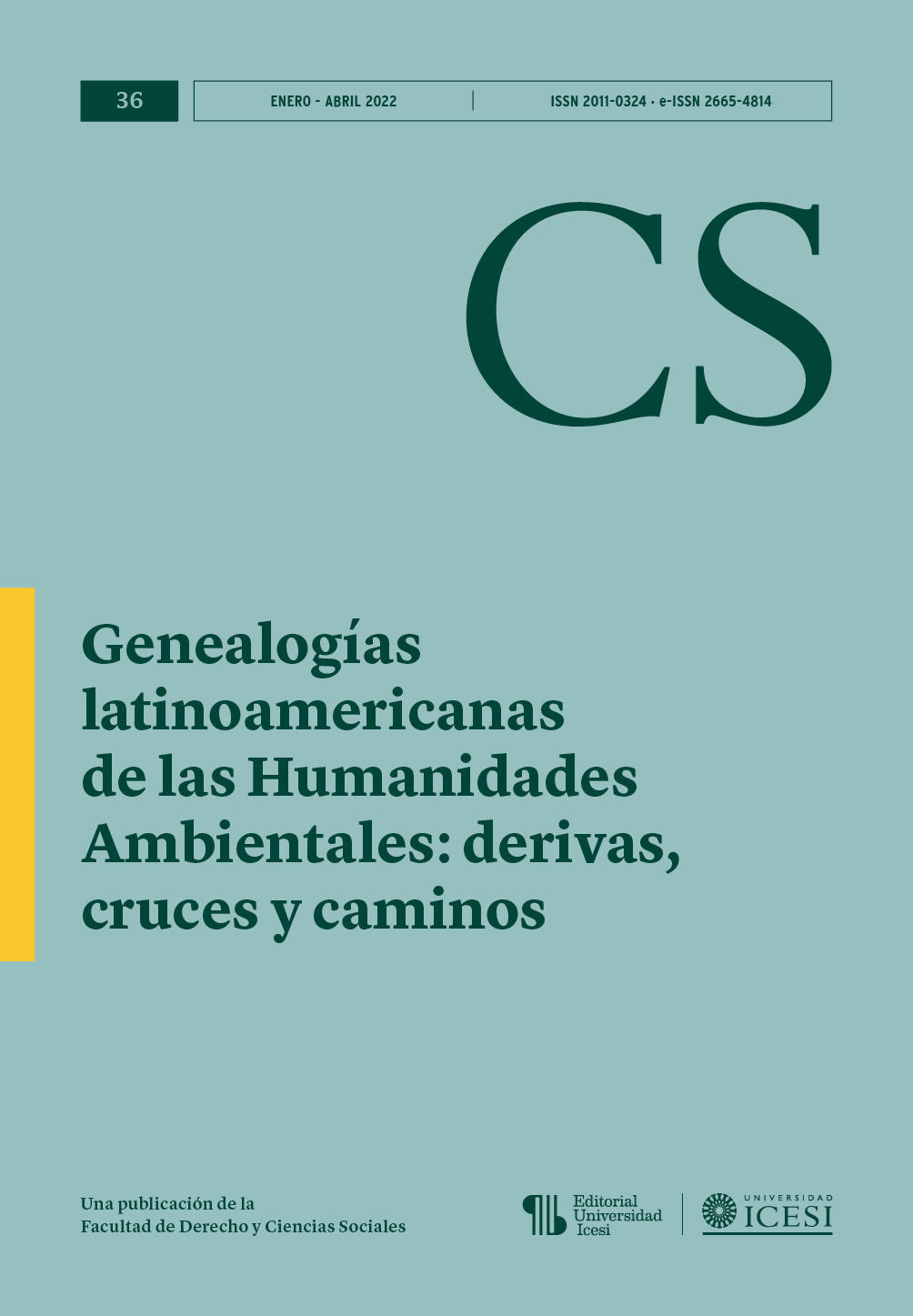Mapeo ecopolítico: una metodología de investigación multiespecie para la comunicación ambiental
DOI:
https://doi.org/10.18046/recs.i36.5275Palabras clave:
metodologías creativas, cartografías colectivas, comunicación ambiental, estudios multiespecie, cohabitación, coexistenciaResumen
El Mapeo Ecopolítico es una metodología experimental que busca mapear encuentros amorosos y desastrosos entre humanos y su entorno más que humano. Esta metodología, primeramente acuñada por un grupo transdisciplinario de artistas e investigadores en el sur de Chile, se desarrolla a través de sesiones de mapeo colectivo utilizando un enfoque ecopolítico con el fin de rastrear las relaciones de poder entre diferentes especies. En este informe de investigación expandimos acerca de nuestras aproximaciones a esta metodología a partir de tres escalas y territorios diferentes: Cuenca del Biobío (Chile), la Ciudad de Berlín (Alemania) y Europa (Continente). Cada caso presentó un fuerte componente de comunicación ambiental, que terminó en la producción de mapas ilustrados. El enfoque metodológico que aquí se propone es a la vez íntimo, político y situado. El mapa se propone no como un supuesto artefacto políticamente neutral, sino como una herramienta para la educación ambiental, la comunicación y el activismo. Ofrecemos el concepto y enfoque, esperando que esta metodología pueda ser practicada y desarrollada por otros humanos, aliados en la producción de parentescos tentaculares.
Descargas
Referencias
Abram, David (1996). The Spell of the Sensuous. New York: Vintage Books.
Anderson, David George (2000). Identity and Ecolog y in Arctic Siberia: The Number One Reindeer Brigade. Oxford: Oxford University Press.
Bennett, Nathan J.; Roth, Robin; Klain, Sarah C.; Chan, Kai; Christie, Patrick; Clark, Douglas A....; Wyborn, Carina (2017). Conservation social science: Understanding and integrating human dimensions to improve conservation. Biological Conservation, 205, 93-108.
Bullard, Robert D. (2011). Sacrifice Zones: The Front Lines of Toxic Chemical Exposure in the United States by Steve Lerner. Environmental Health Perspectives,119(6), A266.
Casti, Emanuela (2014). A reflexive cartography and environmental conservation: a model of participatory zoning. Global Bioethics, 25(2), 125-135.
De Young, Raymond (2000). Expanding and evaluating motives for environmentally responsible behaviour. Journal of Social Issues, 56(3), 509-526.
Gibson, Katherine; Bird Rose, Deborah; Fincher, Ruth (2015). Manifesto for Living in the Anthropocene. Santa Barbara: Punctum Books.
Gillespie, Katie; Narayanan, Yamini (2020). Radical Intimacies: A Multispecies Politics of Care and Kinship. Retrieved from https://networks.h-net.org/node/73374/announcements/6578999/cfp-edited-volume-radical-intimacies-multispecies-politics-care
Haraway, Donna (2016). Staying with the trouble: Making kin in the Chthulucene. Durham: Duke University Press.
Hedesan, Jo; Tendler, Joseph (2017). An Analysis of Thomas Kuhn’s The Structure of Scientific Revolutions. London: Macat Library.
Hulme, Mike (2009). Why we disagree about climate change: Understanding controversy, inaction and opportunity. Cambridge: Cambridge University Press.
Huntington, Henry P. (1998). Observations on the Utility of the Semi-directive Interview for Documenting Traditional Ecological Knowledge. Arctic, 51(3), 237-242.
Kirksey, S. Eben; Helmreich, Stefan (2016). The Emergence of Multispecies Ethnography. Cultural anthropology, 25(4), 545-576.
Krueger, Tobias; Maynard, Carly; Carr, Gemma; Bruns, Antje; Mueller, Eva Nora; Lane, Stuart (2016). A transdisciplinary account of water research. Wiley Interdisciplinary Reviews: Water, 3(3), 369–389.
Latour, Bruno (2018). Down to earth: politics in the new climatic regime. Cambridge: Polity Press.
Linder, Rhema (2016). Analyzing Creative Processes: Qualitative Methods Meets Visual Analytics. Unpublished.
Maron, Martine; Simmonds, Jeremy S.; Watson, James EM (2018). Bold nature retention targets are essential for the global environment agenda. Nature Ecolog y & Evolution, 2(8), 1194-1195.
Moore, Jason W. (2015). Capitalism in the Web of Life: Ecolog y and the Accumulation of Capital.London: Verso Books.
Nygren, Anja; Rikoon, Sandy (2008). Political Ecology Revisited: Integration of Politics and Ecology Does Matter. Society & Natural Resources, 21(9), 767-782.
Okaka, Wilson (2016). Developing Effective Science Communication for Ecological Crisis, Climate Change, and Eco-Justice Issues in Africa. Conference: International Conference on Sustainable Alternatives to Ecological Justice for Poverty Reduction in Africa.
Pievani, Telmo (2014). The sixth mass extinction: Anthropocene and the human impact on biodiversity. Rendiconti Lincei, 25(1), 85-93.
Pohl, Christian (2011). What is progress in transdisciplinary research? Futures, 43(6), 618–626.
Risler, Julia; Ares, Pablo (2016). Manual of Collective Mapping. Buenos Aires: Argentina.
Robbins, Paul (2011). Political Ecology: A Critical Introduction. Malden: John Wiley & Sons.
Safiullin, Marat Rashitovich; Ermolaeva, Polina Olegovna; Yermolaev, Oleg Petrovich; Selivanov, Renat Nailevich (2015). Current Perspectives on Social Mapping of Urban Territories. Asian Social Science, 11(6), 207-213.
Schwarze, Steve (2007). Environmental Communication as a Discipline of Crisis. Environmental Communication, 1(1), 87-98.
Sharman, Martin; Mlambo, Musa C. (2012). Wicked: The problem of biodiversity loss. GAIA-Ecological Perspectives for Science and Society, 21(4), 274–277.
Stengers, Isabelle (2018). Another Science is Possible: A Manifesto for Slow Science. London: Polity Press.
Sterback, Elise (2014). Creative Ecology: A New Model For Resilience in Creative Communities. Wellington: Creative Coalition Auckland.
Tsing, Anna (2015). The mushroom at the end of the world: On the possibility of life in capitalist ruins. Princeton: Princeton University Press.
van Dooren, Thom; Kirksey, Eben; Münster, Ursula (2016). Multispecies Studies: Cultivating Arts of Attentiveness. Environmental Humanities, 8(1),1-23.
Wildnisstadt Berlin (2021). What if Berlin was a National Park City? Retrieved from: https://storymaps.arcgis.com/stories/d76ff4efd7f14c728f0307a0677d52f8
WWF (2018). Living Planet Report - 2018: Aiming Higher. Grooten, M. and Almond, R.E.A.(Eds). Gland, SwitzerlandL WWF
Descargas
Publicado
Número
Sección
Licencia
Derechos de autor 2022 Jens Benöhr

Esta obra está bajo una licencia internacional Creative Commons Atribución-NoComercial 4.0.
© Derechos reservados de autor
El material de esta publicación puede ser reproducido sin autorización, siempre y cuando se cite el título, el autor y la fuente institucional.
El contenido publicado en Revista CS se distribuye bajo la licencia Creative Commons BY-NC 4.0 Atribución/Reconocimiento-NoComercial 4.0 Internacional.
Usted es libre de:
Compartir — copiar y redistribuir el material en cualquier medio o formato.
Adaptar — remezclar, transformar y construir a partir del material.
Bajo los siguientes términos:
Atribución — Usted debe dar crédito de manera adecuada, brindar un enlace a la licencia, e indicar si se han realizado cambios. Puede hacerlo en cualquier forma razonable, pero no de forma tal que sugiera que usted o su uso tienen el apoyo de la licenciante.
NoComercial — Usted no puede hacer uso del material con propósitos comerciales.












